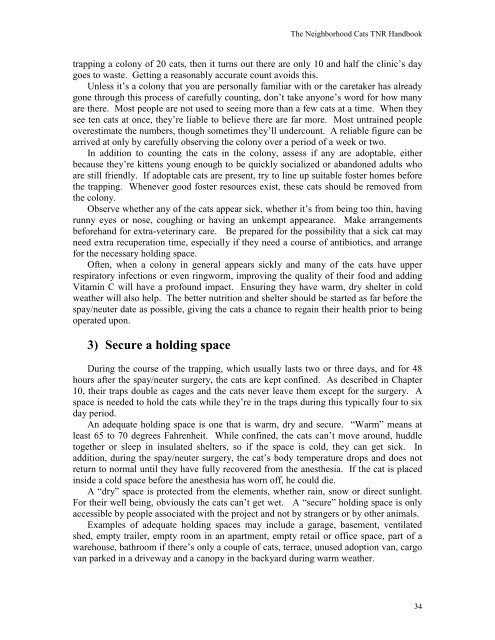Create successful ePaper yourself
Turn your PDF publications into a flip-book with our unique Google optimized e-Paper software.
The <strong>Neighborhood</strong> <strong>Cats</strong> <strong>TNR</strong> <strong>Handbook</strong><br />
trapping a colony of 20 cats, then it turns out there are only 10 and half the clinic’s day<br />
goes to waste. Getting a reasonably accurate count avoids this.<br />
Unless it’s a colony that you are personally familiar with or the caretaker has already<br />
gone through this process of carefully counting, don’t take anyone’s word for how many<br />
are there. Most people are not used to seeing more than a few cats at a time. When they<br />
see ten cats at once, they’re liable to believe there are far more. Most untrained people<br />
overestimate the numbers, though sometimes they’ll undercount. A reliable figure can be<br />
arrived at only by carefully observing the colony over a period of a week or two.<br />
In addition to counting the cats in the colony, assess if any are adoptable, either<br />
because they’re kittens young enough to be quickly socialized or abandoned adults who<br />
are still friendly. If adoptable cats are present, try to line up suitable foster homes before<br />
the trapping. Whenever good foster resources exist, these cats should be removed from<br />
the colony.<br />
Observe whether any of the cats appear sick, whether it’s from being too thin, having<br />
runny eyes or nose, coughing or having an unkempt appearance. Make arrangements<br />
beforehand for extra-veterinary care. Be prepared for the possibility that a sick cat may<br />
need extra recuperation time, especially if they need a course of antibiotics, and arrange<br />
for the necessary holding space.<br />
Often, when a colony in general appears sickly and many of the cats have upper<br />
respiratory infections or even ringworm, improving the quality of their food and adding<br />
Vitamin C will have a profound impact. Ensuring they have warm, dry shelter in cold<br />
weather will also help. The better nutrition and shelter should be started as far before the<br />
spay/neuter date as possible, giving the cats a chance to regain their health prior to being<br />
operated upon.<br />
3) Secure a holding space<br />
During the course of the trapping, which usually lasts two or three days, and for 48<br />
hours after the spay/neuter surgery, the cats are kept confined. As described in Chapter<br />
10, their traps double as cages and the cats never leave them except for the surgery. A<br />
space is needed to hold the cats while they’re in the traps during this typically four to six<br />
day period.<br />
An adequate holding space is one that is warm, dry and secure. “Warm” means at<br />
least 65 to 70 degrees Fahrenheit. While confined, the cats can’t move around, huddle<br />
together or sleep in insulated shelters, so if the space is cold, they can get sick. In<br />
addition, during the spay/neuter surgery, the cat’s body temperature drops and does not<br />
return to normal until they have fully recovered from the anesthesia. If the cat is placed<br />
inside a cold space before the anesthesia has worn off, he could die.<br />
A “dry” space is protected from the elements, whether rain, snow or direct sunlight.<br />
For their well being, obviously the cats can’t get wet. A “secure” holding space is only<br />
accessible by people associated with the project and not by strangers or by other animals.<br />
Examples of adequate holding spaces may include a garage, basement, ventilated<br />
shed, empty trailer, empty room in an apartment, empty retail or office space, part of a<br />
warehouse, bathroom if there’s only a couple of cats, terrace, unused adoption van, cargo<br />
van parked in a driveway and a canopy in the backyard during warm weather.<br />
34


